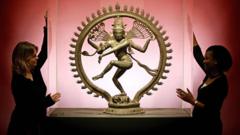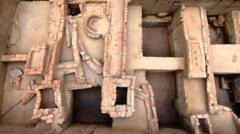Rajaraja Chola's empire, famed for its monumental Brihadishvara temple and extensive maritime trade networks, marked a transformative era in medieval India, making considerable strides in economic and cultural development that resonate even today.
The Chola Dynasty: A Marvel of Medieval Innovation and Culture

The Chola Dynasty: A Marvel of Medieval Innovation and Culture
The Chola dynasty's legacy showcases a flourishing civilization that influenced trade, architecture, and culture, demonstrating their significance beyond India's borders.
The history of the Chola dynasty reveals an incredible narrative of innovation, conquest, and cultural sophistication that spans centuries. By 1000 CE, as Europe grappled with fragmentation, India was witnessing the rise of an empire that would leave an indelible mark on the world stage. At the heart of this empire was King Rajaraja Chola, who directed the construction of the magnificent Brihadishvara temple within just ten years of his reign. Standing at an impressive height of 216ft (66m) and built from 130,000 tonnes of granite, this monumental structure housed the golden, ruby-encrusted figure of the Hindu god Shiva, showcasing the immense wealth and artistry of the Chola period.
Previously, the Cholas were just one of many regional powers in Southern India. However, they ignited a transformation through military prowess and cultural renaissance, culminating in a new, recognizable brand of Hinduism that intertwined devotion and public relations. Key figures such as Sembiyan Mahadevi, Rajaraja’s great-aunt, played a crucial role in elevating the family's image by emphasizing their devotion to Shiva through restored temples and public works. Rajaraja himself complemented these efforts with military campaigns that extended Chola influence beyond the subcontinent, effectively establishing control over the island of Lanka and the Deccan Plateau.
The wealth garnered from conquests directly funded the construction of the Brihadishvara temple, which not only stood as a monument to Rajaraja's glory but also became a multifunctional hub of civic administration. This temple operated under a system that ensured economic stability, channeling resources into irrigation projects and agriculture, indicating a sophisticated approach to statecraft seldom seen during the medieval era.
The Chola dynasty's maritime ambitions were as significant as their land conquests. Under Rajaraja’s successor, Rajendra, alliances were forged with Tamil merchant corporations, leading to extensive trade networks across the Indian Ocean that predated similar structures set up by European powers centuries later. Rajendra's maritime expeditions, including the attack on the Malay city of Kedah, illustrate the Cholas' influence and adaptability in global trade, which saw Tamil merchants establishing independent operations across Southeast Asia.
By the late 11th century, Tamil merchant influence stretched far into modern-day Myanmar and Thailand, with Tamil communities establishing successful roots as far as China. This vibrant exchange fostered a multicultural environment during the Chola period, where people from diverse backgrounds coexisted and collaborated in artistic and commercial endeavors.
The artistic achievements of the Chola dynasty also left a lasting legacy. Lavish temple complexes adorned with exquisite bronzes, such as the iconic Nataraja figures, stand testament to their craftsmanship, rivaling Western masters of later periods. Alongside this, Tamil poets innovated literary forms that encapsulated the era's complexity, blending history and mythology in exciting ways.
Today, the remnants of the Chola Empire's grandeur, from their remarkable temples to their impact on global trade and culture, remain evident across various modern disciplines. The Cholas were not merely rulers of a regional empire but innovators whose contributions helped shape societal norms and artistic standards that resonate throughout history, making them a significant subject of study for historians and scholars alike. Anirudh Kanisetti's work, "Lords of Earth And Sea: A History of The Chola Empire," brings this dynamic era to life, emphasizing the extraordinary capabilities of a dynasty that thrived through adaptation and creativity.



















